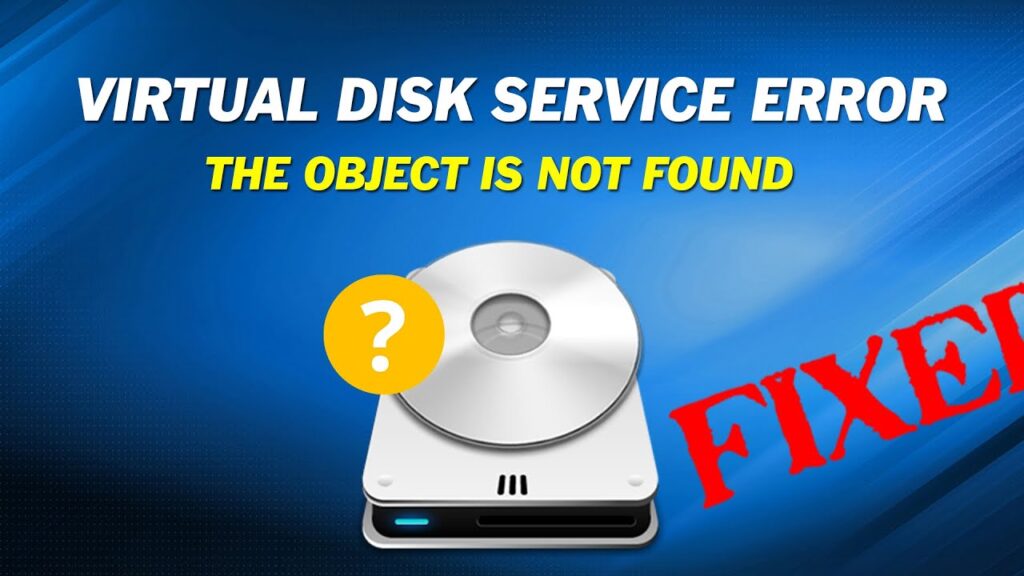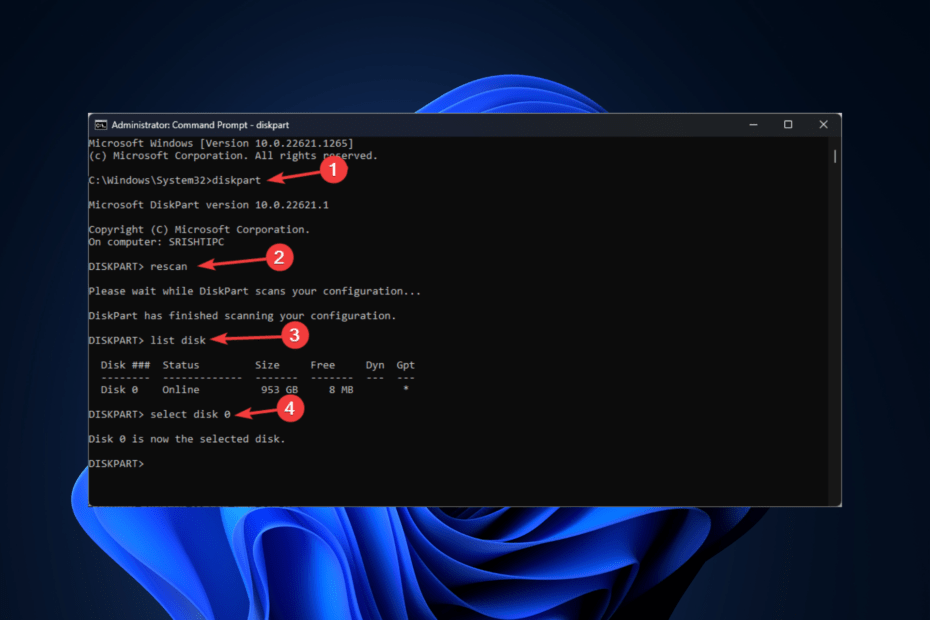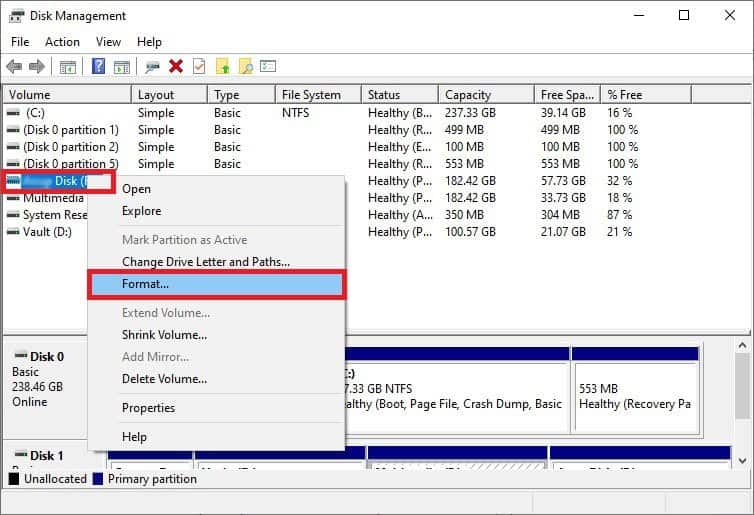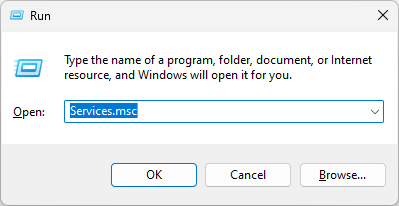What exactly is virtual disc service? According to Microsoft, a virtual disc service (VDS) is a collection of application programming interfaces (APIs) that provide a unified interface for disc management.
It provides a complete solution for managing storage hardware and discs, as well as creating partitions on these storage devices. To handle storage hardware, virtual disc service provides two sets of providers: the built-in VDS software providers allow you to control disc space and partitions at the OS level, while the hardware providers allow you to manage hardware RAID arrays.

The VDS APIs allow applications to manage disks and partitions, so you may write your software or use programs like Disk Management or disk part command line to perform tasks like creating volumes, formatting volumes, assigning drive letters, converting basic disks to dynamic discs, and so on.
Although VDS has numerous benefits, it does occasionally cause problems. The virtual disc service error covered in this article occurs while running disk part commands and is frequently accompanied by a range of error messages. When an error occurs, the task at hand cannot be finished. This issue can occur when you use the diskpart.exe command line to handle your discs and volumes, such as formatting a disc to FAT32, cleaning a disc, converting a disc between GPT and MBR, and so on. In this video, we’ll go through some common issues and offer solutions to help you fix them.
Recommended Post:- How to Unlock Drive on Windows 10: Five Ways to Remove a Lock
What causes the virtual disk service error: the object is not found on the Screen?
There could be several causes for this virtual disc service problem; some of the most common are:
If you attempt to manage a disc or volume that is offline, the Virtual Disk Service (VDS) will be unable to locate it, resulting in the error.
- Disk or volume is corrupted: If the disc is corrupted, VDS may be unable to access it, resulting in this disc error.
- Problems with the VDS service: If VDS is not functioning or performing properly, it may be unable to access the disc, resulting in an error
- Virus: Malware infection can prevent you from partitioning your device. If your computer is infected with a virus, you will most certainly see this VDS error during partitioning.
- Missing system files – This virtual disc issue might occur if the system files are faulty or missing. To resolve this problem, you must repair system files.
What is the source of the problem?
Windows File Explorer cannot format partitions greater than 32GB to the FAT32 file system, even though it can access and use huge FAT32 partitions without trouble. In this instance, users will attempt to format the drive to FAT32 in diskpart, which frequently results in an error.

This constraint imposed by Windows is logical and understandable, as FAT32 is not the best solution for managing vast amounts of disc space. A very big FAT32-formatted drive may be unstable and prone to problems such as partition corruption. Nonetheless, if you want to format a partition to FAT32, there is a simple way to do it.
How to fix the virtual disk service error: the object is not found Error?
Let us now look at all of the solutions that will assist you in resolving this issue in the following portion of the article. Let us get started.
Solution 1: The volume is too large.
You may obtain the error message “Virtual Disk Service error: The volume size is too large” when attempting to format a local or removable hard drive using diskpart commands. This problem usually occurs when you use diskpart to format a big partition or USB device to the FAT32 file system.
When you try to format a disc or partition in Windows File Explorer, you will be given the option of using the NTFS or exFAT file systems. Here’s an example of real-world use of this problem:
We propose that you format the drive using DiskGenius. DiskGenius is free disc partition software that allows users to circumvent Windows’ 32GB limit. The free edition is sufficient for formatting tasks and can format partitions to NTFS, FAT32, exFAT, EXT4, EXT3, and EXT2. The formatting procedure is described in the section that follows.

- Step 1: Install and run DiskGenius from your Windows PC, and then select the partition to format.
- Step 2: Right-click on the FAT32 partition you wish to format and select “Format Current Partition,” as seen below:
- Step 3: Choose a file system from the drop-down menu and click the Format button. Then, to proceed, click the Yes button.
Note: By default, DiskGenius conducts rapid formatting, but you can choose “Surface Scan” to see if the drive contains issues. After formatting, regardless of partition size, the NTFS partition will be changed to FAT32.
Solution 2: The object has not been located
“Since there is no recovery volume on the device and we cannot restore Windows, you are attempting to build a new partition on my laptop using the disk part in Command Prompt. As a result, we sought to establish a partition on our own.
We learned about partitioning via the Internet. Here are some commands: We attempted: to list disc, choose disc 0, clean, and create a primary partition. The error message ‘Virtual Disk Service Error: the object is not found’ appears.”
Have you encountered a similar issue? Diskpart occasionally fails to function as planned for unknown reasons. If you are unable to create a partition using disk part commands, you can complete the process using free third-party software.
DiskGenius allows you to create new partitions from either unallocated disc space or existing partitions, making it simple to build partitions.
- Step 1: Download and run DiskGenius Free Edition on your computer, then navigate to the disc where you wish to create a partition.
- Step 2: From the toolbar, select unallocated disc space and click the Create Partition button. The Create New Partition window appears next.
- Step 3: After configuring partition parameters such as partition type, file system type, partition size, and so on, click the OK button.
- Step 4: Choose the Save All option to format the newly formed partition. Following that, you can save data to the partition.
Solution 3: Cleaning the disc holding the current boot, system, pagefile, crashdump, or hibernation volume is not permitted
If you use the disk part clean command to clean the system disc, the error “Virtual Disk Service error: Clean is not allowed on the disc holding the current boot, system, pagefile, crashdump, or hibernation volume” will appear. Because the operating system does not enable you to clear the disc while the system is running, you can only clean the disc where Windows is installed while the system is not running.
If you have a Windows installation disc, you can insert it into your computer and let it boot from it. Then, choose to Repair your machine> Troubleshoot> Advanced Options > Command Prompt. Following that, retype disk part instructions to wipe the system disc.
But, if you do not have a Windows installation disc or your computer does not have a CD-ROM drive, you can wipe your hard drive by following the instructions outlined here.
- Step 1: Run DiskGenius from your computer and select “Reboot to DiskGenius WinPE Version” from the File menu, as seen in the image below.
DiskGenius will prepare to boot to its WinPE version, and you must be patient while it does so. When it’s finished, you’ll be asked if you want to restart the computer right away. To proceed, press the OK button.
DiskGenius can also create a bootable USB disc based on Windows PE. You can give it a shot if you have a USB flash drive.
Step 2: After the computer boots into DiskGenius WinPE edition, select the system drive, click Disk, and then select Erase All Partitions.
This function will remove all partitions and data on the hard drive you’ve chosen, and you will lose data if there is a backup. If you accidentally delete a partition or files, you can use DiskGenius to perform data recovery or partition recovery to recover your lost data. If you wish to permanently remove data from a hard disc, use the Wipe Sector option from the Tools menu.
Note: If the system partition is deleted, the machine will not be able to boot normally, and you will need to reinstall Windows.
Solution 4: The media is not writable
If you used the Windows iso program to build a bootable drive and it failed to owe to a write-protect problem. We attempted to format it using File Explorer and Disk Management, but nothing worked.
Lastly, we tried formatting the drive with fs=fat32 fast in Command Prompt, but we still receive the problem ‘Virtual disc service error: the media is write protected.’ Does this mean the drive is dead? Do you have any suggestions for removing the protection?”
Disable registry write protection
- Step 1: In Windows 10, enter regedit in the search box and press the Enter key. This launches the Registry Editor.
- Step 2: In the left pane, expand the following keys: HKEY LOCAL MACHINE\SYSTEM\CurrentControlSet\Control\StorageDevicePolicies.
If your machine does not have StorageDevicePolicies, you must establish one. Right-click “Control” and select “New” and “Key”. Then give it the name StorageDevicePolicies. - Step 3: In the right-hand pane, double-click the WriteProtect value. You can now set the Value data to 0 instead of 1. Then, to save the modification, click OK.
- Step 4: Exit Registry Editor and restart the computer. Then check to see if the write protection has been removed.
Solution 5: Examine and fix the drive’s faulty sectors
When a disc cannot be formatted by the system, it is required to do faulty sector checking, as this indicates that the drive cannot be written properly. If a disc cannot be read or written normally, it most certainly has faulty sectors. Because DiskGenius Free makes it simple to check for faulty sectors on a hard drive or USB disc, you can give it a shot when the virtual disc service states that the drive cannot be formatted due to a write error.
- Step 1: Attach the disc to your computer and run DiskGenius. In the application, choose the disc and then select Disk -> Check Or Repair Bad Sectors, as seen below.
- Step 2: From the pop-up box, click the Start Verify button, and DiskGenius begins scanning the disc to see if it has any faulty sectors.
DiskGenius color-codes sector status and defective sectors are labeled with a red block (Damaged). After the scanning is finished, you can try to repair any bad sectors on the disc. Before restoring faulty sectors, ensure that all files on the disc have been backed up.
Solution 6: Connecting Disk Management to a Virtual Disk Service
Windows Disk Manager does not function properly and reports that it is unable to connect to the Virtual Disk Service, or “Disk Management was unable to launch Virtual Disk Service (VDS) on (Your Computer Name). This can occur if the remote machine does not support VDS or if a connection cannot be created due to Windows Firewall blocking it. See Troubleshooting Disk Management in Disk Management Help for further information on identifying and correcting this issue.”
Step 1: Launch Command Prompt as administrator. Enter the command SFC /scannow. The command begins scanning system files, which could take some time.
Step 2: Type the following commands, pressing Enter after each one.
- Dism /Online /Cleanup-Image /CheckHealth
- Dism /Online /Cleanup-Image /ScanHealth
- Dism /Online /Cleanup-Image /restorehealth
Step 3: After all of these commands have been executed, restart the computer.
Solution 7: The disc in question is not convertible. CDROMs and DVDs are examples of non-convertible discs.
You are very likely to receive the “The supplied disc is not convertible, resulting in a virtual disc service error. CDROMs and DVDs are examples of non-convertible discs “When the DiskPart command cannot convert the selected disc to GPT or MBR format, an error occurs.
DiskGenius’ conversion from GPT to MBR does not erase any files from the hard drive. To convert a disc to GPT, follow these instructions.
- Step 1: Run DiskGenius Free version on your computer and select the hard drive whose partition table style you want to modify. Next select “Disk” -> “Convert To GUID Partition Table”.
- Tip: Choose “Convert to MBR Partition Table” if you wish to convert GPT to MBR.
- Step 2: Click “OK” to proceed with the conversion.
- Step 3: To save changes to the partition table, click the “Save All” option.
How can you enable virtual disk services?
The methods to activate virtual disc services are outlined below.
- Step 1: To open the Windows service manager, press the Window + R keys together. Type services.msc in the Run box and press the Enter key.
- Step 2: Go down to find the Virtual Disk service.
- Step 3: Now, double-click the service to launch it.
- Step 4: Choose Automatic or Manual as the Starting type.
- Step 5: To save the changes, click OK.

How do you solve DiskPart’s reference to an out-of-date object?
If you wish to repair DiskPart has referred to an out-of-date object. Then, using the RESCAN command, refresh the object. To run this command, follow the steps below.
- Step 1: Choose the Search button and enter cmd.
- Step 2: Open the Command Prompt in this step.
- Step 3: Type diskpart and press the Enter key.
- Step 4: Type rescan again and press Enter.
Following the execution of the rescan command If the problem persists, exit DiskPart and restart it or the computer.
Conclusion
If you see the notice “Virtual Disk Service error: The object is not found” while creating a primary partition in Diskpart, you can build a partition on that disc using another tool. If a disc fails and is unable to contain a partition, you can replace it with a healthy one by cloning everything from one disc to another.







